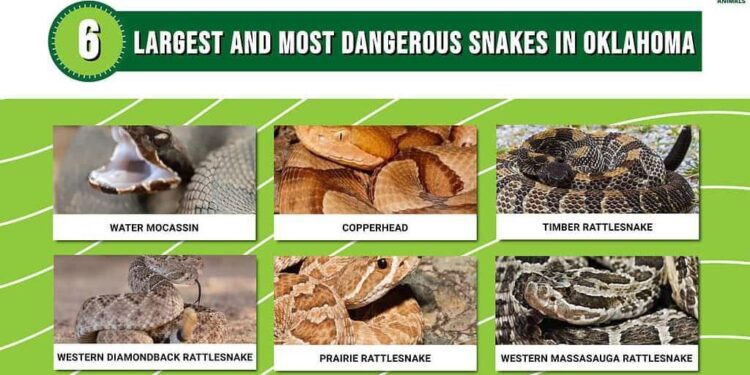Every time I get on social media I am confronted with a picture of someone removing a snake from their house, pool, barn or other structure. I’ve lost count over the last couple of weeks of people sending me pictures of big snakes, sometimes poisonous, that have been showing up at their homes.
The Oklahoma snake identification Facebook page has over 72K followers, so I must not be the only one that finds snakes interesting.
While it’s been a relatively cool spring the heat is finally arriving, reptiles are starting to be more active. Their body systems actually function better in warmer temperatures. But while heat speeds up a snake’s metabolism, it also makes the need to feed more often.
So, the more a snake has to hunt for a meal, the more they move around. Thus bringing in unwanted encounters with humans.
According to the Oklahoma Department of Wildlife Conservation, there are approximately 83 species of reptiles found in the Sooner State, of those 53 are snakes, and of those snakes only seven are poisonous.
So while some folks view snakes with disdain, the truth is that very few pose any danger for humans, and even those do so much more good by thinning rodent populations. Snakes play a very important role in controlling insect, rodent, and other fast reproducing critter populations.
Without snakes we would soon be overrun with all types of critters, some that carry and spread disease or damage crops. As an example, mice produce very rapidly. Gestation in mice is around 20 days. They typically have between 10 to 12 babies in a litter. The babies are weaned at around 3 weeks of age. The female resumes cycling at about 2 to 5 days after weaning the babies. So, what does this all mean? Mice can potentially have a new litter of 10-12 babies about every 7 weeks. That works out to be around 8 litters per year which equals approximately 96 newborns per year per female mouse.
Ophidiophobia is the fear of snakes, and doctors realize that for some people, that fear cannot be controlled. For others, education and identification can help ease some of that trepidation, and may spare the life of a critter that is much more valuable.
All snakes can bite, but only a few are dangerous. But those interaction are on the rise in Oklahoma. Two wet years has increased vegetative cover, and with an increase in places to hide, rodent populations are exploding. So with more food species, Mother Nature provides more predators to help keep populations in check.
More mice = more snakes = more human interactions = more snake bites.
The Oklahoma Center for Poison & Drug Information (OCPDI) is a state organization that provides information and management of potentially toxic exposures; so far this year, OCPDI has handled a 25 percent increase in human snakebite victims over last year. Snakebites are not required to be reported in Oklahoma, so the OCPCI says that there are likely many more bites than this.
“As the water has increased in areas, it’s been driving the snakes out of their usual habitat,” said Dr. William Banner with the OCPDI. “That puts them in more contact with people.”
So if only a few snakes can be dangerous, then learning to identify them can help avoid confrontations that end up in humans getting bit.
Of the 50 or more species of snakes native to Oklahoma, only seven are venomous to humans. All seven of the venomous species of snakes found in Oklahoma are from the pit viper family (this does not include the Texas coral snake which is rarely found in extreme Southeastern Oklahoma). Pit vipers include rattlesnakes, copperheads and water moccasins, and all have the ability to sense or detect heat in their prey with the use of heat sensing “pits” just below the eyes and nostrils.
According to Mike Porter, Senior Wildlife and Fisheries Consultant for the Noble Research Institute, while these poisonous snakes all have a few easy to identify characteristics, a person might have to get too close to see them, so color is the best way to initially identify them.
“This is not as difficult as it might seem because the seven venomous species can be further lumped into three types, rattlesnakes (five species), copperhead (one species) and cottonmouth (one species). If you learn to identify a rattlesnake, a copperhead and a cottonmouth, then you can quickly tell whether an Oklahoma snake is venomous or not,” Said Porter.
While the pit vipers typically have triangular or arrowhead shaped heads and vertical pupils in the eyes, other Oklahoma snakes can look similar. So caution needs to be taken when making identification.
According to oksnakes.org, which is a great resource for identifying Oklahoma reptiles here are the common characteristics of the poisonous snakes found in Southwest Oklahoma:
Rattlesnakes – As their name implies, rattlesnakes typically have rattles, but they may have only a button (first segment of a rattle) or a squared-off tail if they lose all their rattle segments, which is rare.
Western diamond-backs can be identified by the dark diamonds on its back that are outlined in white. They also have black and white bands that ring the end of the tail just before the rattle.
Pygmy rattlesnakes are much smaller (hence the name) It has a gray to pinkish body with dark blotches down its back and one to three rows of spots along each side. Most pygmies have a faint reddish-brown stripe running along the center of their back. The rattle is very small, as compared with other rattlesnake species, and often isn’t audible unless heard at close range.
Western massasuga rattlesnakes are between the other two in size. This rattlesnake has a row of dark brown blotches that run down the length of its back. It also has three small rows of lighter colored blotches along each side. Massasauga means “great river mouth” in the Chippewa language.
Bites from rattlesnakes are usually more severe than bites from other snakes. A bite should be considered a medical emergency.
Copperhead – this may be the easiest of the poisonous snakes to identify by color. Copperheads have alternating bands of darker and lighter copper, reddish-brown or pinkish colors. Ideally colored to hide in forest undercover, they are easy to identify when finally seen.
Biologists use to classify this group into 3 subspecies, but now that has changed to two different species – eastern, and broad banded. Coloration on both is very similar and most field guides still have them listed as a single species.
Copperhead bites can be severe, but not as bad as other snakes. About half of all copperhead bites result in only mild swelling and pain.
Western water moccasin – also called a cottonmouth due to the white lining of the interior of the mouth, and it’s propensity to open and flash this warning signal when startled. This heavy-bodied snake has a pattern that is typically obscured by its dark coloration. The back is usually a mix of black, brown, and olive green, and the belly is white or cream-colored with black mottling.
Another interesting habit is that cottonmouths swim with their head up and their entire body on the surface of the water, unlike the harmless water snakes, which swim with the lower half of their body underneath the water.
“The cottonmouth is more difficult to distinguish from nonvenomous water snakes because its color can vary somewhat; it can have bands or it can have a relatively consistent color,” said Porter. “The cottonmouth is usually near water, but can be encountered away from water. Usually, the cottonmouth’s most dependable characteristic from a safe distance is a black streak or mark on the side of the head that runs from the eye to just past the corner of the mouth, which is visible from several feet away.”
Cottomouth bites are between rattlesnake and copperhead bites in severity.
If bitten – Scott Schaeffer, OCPDI managing director, said the best treatment is to take the snakebite victim to a hospital or call OCPDI because many techniques used in the field, like cutting into the bite or sucking the venom, don’t help.
“Movies have taught us and unfortunately, it’s just wrong. People can end up causing actually a whole lot more problems by doing some of that stuff. People have lost limbs from some of the treatments in the field or gotten just horrible infections,” Schaeffer said.
Pets are all too many times the victim of a snake encounter. Depending on the size of the pet (usually dogs) and the type of snake, the bite can result in swelling to death. Not many Oklahoma veterinarians carry anti-venom, the cost is just too prohibitive. But the vet and treat the animal for swelling, infection and other side effects.
According to Porter, learning to recognize and understand the venomous snakes might save you, a loved one or a pet from a lot of misery that could result from a close encounter of the bad kind. However, remember, snakes are native creatures, so even venomous species have a place in the big scheme of things.
If you want to brush up on snakes, lizards and frogs of Oklahoma, then “A Field Guide to Oklahoma’s Amphibians and Reptiles” by Greg and Lynnette Sievert is just the book for you. This guide carefully details the mixed bag of salamanders, frogs, turtles, lizards and snakes that can be found within our state’s borders.
“Oklahoma’s diversity of amphibians and reptiles is really incredible,” said Jena Donnell, information specialist with the Wildlife Department. “This book features 135 of the species that can be found in our state; from the collared lizard with a near statewide distribution, to rare salamanders found only in the Ouachita Mountains.”
Tips for identification, a map of the Oklahoma range and information about the diet and preferred habitats are provided for each species. The book’s spiral binding makes it easy to flip through and make comparisons of different species when identifying animals at home or in the field.
For a more “techie” approach to snake identification, check out oksnakes.org. this website has easy to identify photos of venomous and non-venomous snakes found in Oklahoma, or join the Oklahoma Snake Identification Network on Facebook.
Want to reach a local audience and grow your business?
Our website is the perfect platform to connect with engaged readers in your local area.
Whether you're looking for banner ads, sponsored content, or custom promotions, we can tailor a package to meet your needs.
Contact us today to learn more about advertising opportunities!
CONTACT US NOW






